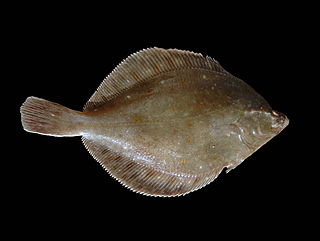
Pleuronectidae, also known as righteye flounders, are a family of flounders. They are called "righteye flounders" because most species lie on the sea bottom on their left sides, with both eyes on their right sides. The Paralichthyidae are the opposite, with their eyes on the left side. A small number of species in Pleuronectidae can also have their eyes on the left side, notably the members of the genus Platichthys.

The common dab is an edible flatfish of the family Pleuronectidae. It is a demersal fish native to shallow seas around Northern Europe, in particular the North Sea, where it lives on sandy bottoms down to depths of about 100 metres (330 ft). It can reach 40 centimetres (16 in) in length and can weigh up to 1 kilogram (2.2 lb), though most specimens grow no longer than 20 centimetres (7.9 in).

The New Zealand sole or common sole, Peltorhamphus novaezeelandiae, is a righteye flounder of the genus Peltorhamphus, found around New Zealand in shallow enclosed waters less than 100 m in depth. Their length is from 25 to 45 cm.
The southern lemon sole, also known as the New Zealand lemon sole, is a righteye flounder, the only species in the genus Pelotretis, found around New Zealand in enclosed waters such as estuaries, harbours, mudflats, and sandflats, in waters less than 385 m in depth. Their length is from 25 to 50 cm.

The yellowtail flounder, also known as the rusty dab, is a species of flatfish in the family Pleuronectidae. Reaching 56 cm (22 in) in length, it has reddish brown upperparts, pale underparts and yellow fins. Both its eyes are on the right (upper) side of its body. Found in the western North Atlantic, it has been fished commercially by North American fisheries for food. A victim of overfishing, the yellowtail flounder is categorized as "Vulnerable" by the International Union for Conservation of Nature.
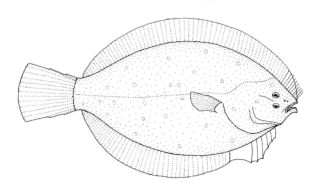
Rhombosolea is a genus of righteye flounders. The four species in this genus can be found in the waters around New Zealand and southern Australia.

Clidoderma is a genus of righteye flounders containing one extant species and two described fossil species from Japan.
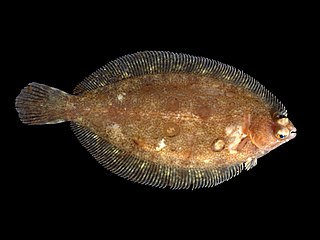
Microstomus is a genus of righteye flounders native to the North Pacific and Northeast Atlantic oceans.

Liopsetta is a genus of righteye flounders native to the northern oceans.
Eopsetta is a genus of righteye flounders native to the North Pacific Ocean.

Hippoglossoides is a genus of righteye flounders native to the North Pacific and North Atlantic oceans.
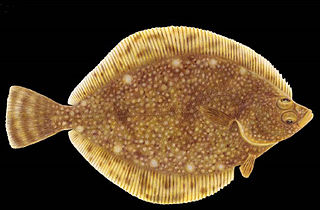
Lepidopsetta is a genus of righteye flounders native to the North Pacific Ocean.

Platichthys is a genus of flatfish native to the North Pacific and North Atlantic oceans. Despite being in the family Pleuronectidae, all three species in the genus Platichthys are often "lefteyed", i.e. they lie on the sea bottom on their right side, with both eyes on the left side.
Nematops is a genus of righteye flounders native to the Indo-West Pacific. Due to their small size and depth of habitation few examples of this genus are caught, and as a result little is known of their morphology and distribution.

Poecilopsetta is a genus of small righteye flounders mainly found in deep water in the Indo-Pacific. Two species, P. beanii and P. inermis, are from the West Atlantic.

Peltorhamphus is a genus of righteye flounders native to the southwest Pacific Ocean around New Zealand and Norfolk Island (Australia).
L. ferruginea may refer to:
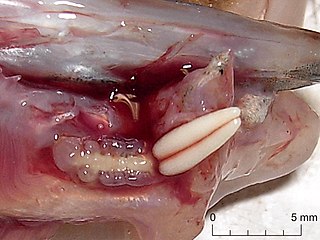
Acanthochondria limandae is a species of copepods in the genus Acanthochondria. They are host-specific ectoparasites of two species of flatfish: the common dab and the European flounder. They attach themselves to the bases of the gill arches of their hosts. They can infest as much as 2 to 30% of fish in a given population.

Samaris is a genus of crested flounders native to the Indo-Pacific.

Samariscus is a genus of crested flounders native to the Indo-Pacific.
















